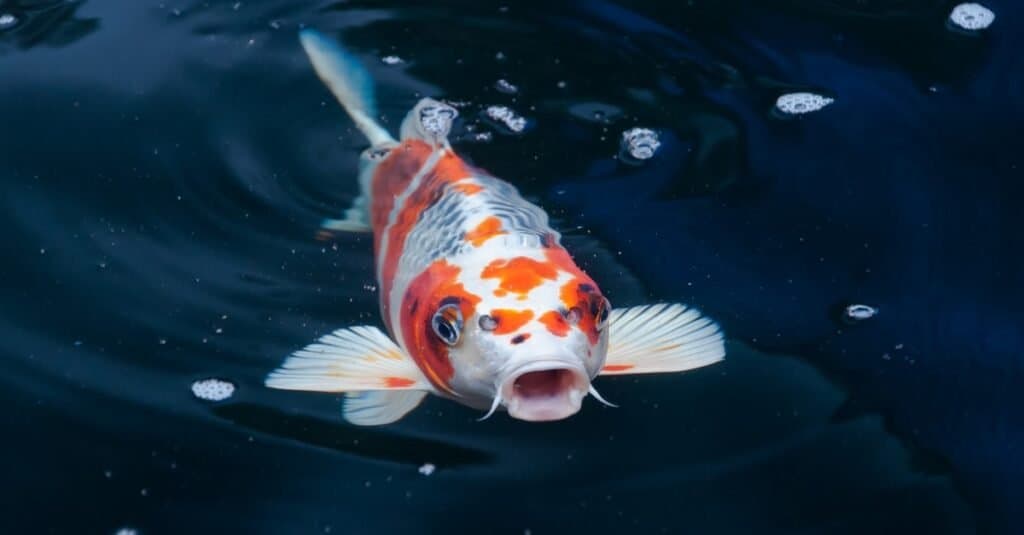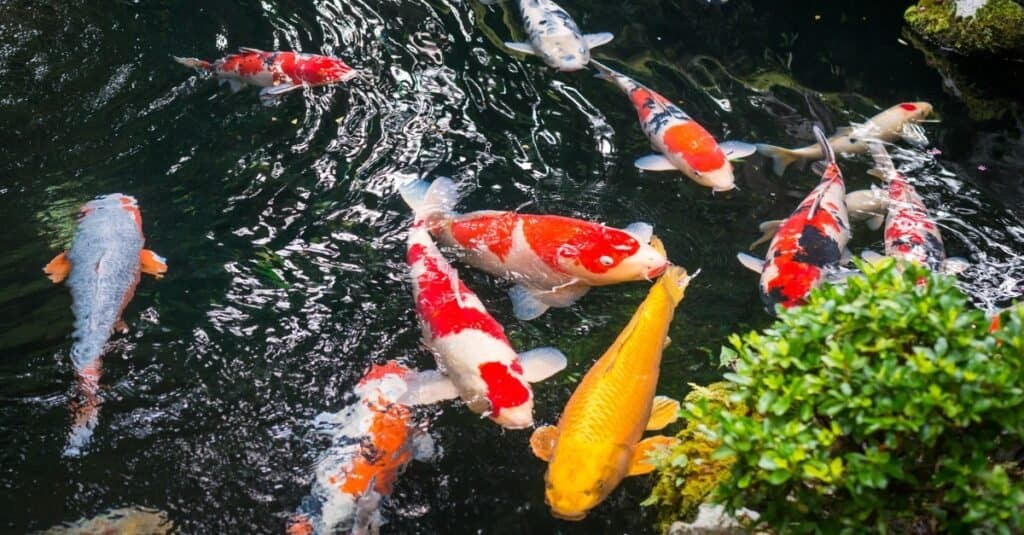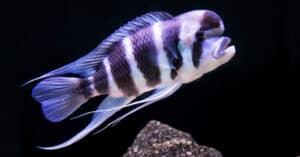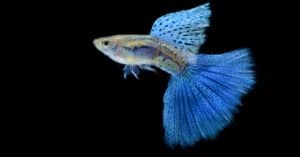Koi fish are staples in ponds and hotel lobbies across the world. Literally translated as “brocaded carp,” modern Japanese koi originated in Niigata, Japan, in the 19th century. Modern koi were originally bred from the Amur carp, a species native to East Asia that has been bred for centuries, primarily as a food source dating back to the 5th century BC.

Thankfully, these beautifully colored fish aren’t used for food anymore but are kept as decorative pets. There are dozens of varieties of koi, each with its own markings and traits. As a common pet, you might be wondering what koi fish eat, especially if you are considering some for your pond. Let’s look at what koi eat and learn how koi thrive in different seasons when food is scarce.
What do koi fish eat?

Koi fish are omnivores that eat worms, larvae, seeds, and algae
©PokkO/Shutterstock.com
Koi fish eat worms, larvae, seeds, algae, insects, and small crustaceans. Technically omnivores, they will eat pretty much anything they can fit in their mouths. Koi don’t have teeth in their circular mouths, making it hard for them to bite or tear. Instead, they have fleshy mouths that are more designed for sucking in food.
Koi are known as “benthic feeders”. Benthic feeders live near the bottom of a body of water and subsist off of what they can find there. More commonly known as bottom feeders, koi sweep the sediment bed of the body of water they live in, searching for any food they can find. While they mostly eat from the bottom of sediment beds, modern domestication has allowed them to eat floating debris and food. This makes fish feedings a regular aspect of owning koi.
Since they have no teeth, many people feed koi food pellets with their bare hands. As the koi feeds, it often sucks the person’s fingers and is quite ticklish. You don’t have to be worried about swimming or placing your hands in water where koi are present as they aren’t harmful to humans.
When koi are introduced into wild habitats, they are known to be quite destructive. Their destructive nature comes from the way they eat. As they glide along the bottom of a waterway, they cause debris and sediment to loosen and unsettle. Known as “turbidity,” the unsettled sediment reduces light penetration and stops plants from taking root, often killing them. Additionally, the extra sediment can be so severe that humans and animals alike can’t drink the water.
Koi are often deliberately released into human-made lakes and golf ponds to help reduce larvae populations and keep plant life down.
A complete list of the foods koi fish eat:
Here is a list of the most common foods a koi will eat in a pond or natural environment:
- algae
- silkworm pupae
- bloodworms
- earthworms
- mosquito larvae
- tadpoles
- duckweed
- hyacinths
Although these are the most common foods that a koi fish will eat, they aren’t very picky about their diet.
Who competes with koi fish for food?

Catfish
and other bottom feeders compete with koi fish for food in the wild.
©Rostislav Stefanek/Shutterstock.com
Since koi live in pond ecosystems, they constantly compete with other fish. In a domesticated and human-built environment, koi don’t have many competitors, however, as the food source (humans) provide food in the form of pellets or feed.
In a wild environment, koi often live with other carp, killifish, and minnows, although they may eat them if they are small enough. They are also found with large fish commonly seen in lakes and streams, like catfish, bass, sunfish, or perch. Since catfish are the closest to the koi in terms of environmental niches (aside from other carp), they could be the fish most often competing with koi in the wild.
How much do koi fish eat?
Koi fish eat based upon the ambient water temperature. The colder the water, the less active they are. The warmer the water, the more active they are. In domesticated situations, koi will usually eat 1-4% of their body weight. When in the wild, koi are always looking for food, sweeping the bottom and sucking up anything they come across.
For domesticated koi, it’s usually better to underfeed than to overfeed as it is more likely to cause health issues.
The ideal diet for koi is 32-36% protein and 3-9% fat. Additionally, you want to ensure that any feed given to koi is low in phosphorus. Too much in a pond ecosystem will promote unchecked algae growth and cause further health problems to koi and any other fish species.
What do koi fish eat in the different seasons?

In domesticated situations, koi will usually eat 1-4% of their body weight.
©M_MUC1968/Shutterstock.com
Koi are poikilothermic, meaning they don’t have a natural ability to regulate their body temperature (like a human can, for example). As a result, their activity levels directly correlate to the ambient temperature of the water, in turn affecting their eating habits from season to season.
During warm seasons where the water is between 71°F and 85°F degrees, a high protein diet is recommended as they are likely to be moving, growing, and altogether more active. Additionally, koi eat multiple times a day, up to a maximum of four.
During the cooler winter seasons, when the water is between 41˚F and 60˚F, a carb-based diet of wheat germ is recommended as long-term energy and conservation is more needed.
When the temperate drops below 40˚F, koi don’t eat and enter a state of hibernation known as torpor. Torpor drastically reduces their energy needs, decreases their metabolism, and slows their bodily functions. This fantastic adaptation allows koi to live in places that get below freezing in the winter.
What do koi eat as pets?
When owning koi as pets, there are a few ways to feed them. Depending on their size, Pet koi can eat store-bought flakes, pellets, and bards. Small koi will find it easier to eat flakes as they are the smallest. For medium to large koi, pellets are ideal. Bars are for the largest koi who can eat it whole, but smaller koi will definitely try to nibble on it.
Additionally, owners can give occasional treats. Things like soft fruits, vegetables, and whole grains are ideal. You should never give your koi fish corn, uncooked rice (it expands in their stomach), white bread, or bugs and fish you caught yourself.
Summary of 8 Key Foods That Koi Fish Eat
| Number | Food |
|---|---|
| 1 | Algae |
| 2 | Silkworm pupae |
| 3 | Bloodworms |
| 4 | Earthworms |
| 5 | Mosquito larvae |
| 6 | Tadpoles |
| 7 | Duckweed |
| 8 | Hyacinths |
The photo featured at the top of this post is © Wiratchai wansamngam/Shutterstock.com
Thank you for reading! Have some feedback for us? Contact the AZ Animals editorial team.






